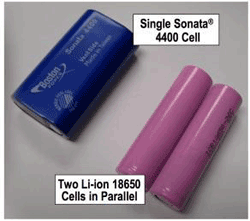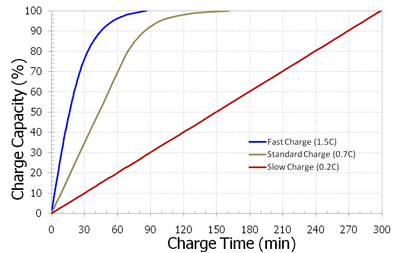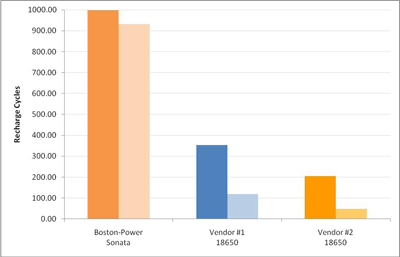Fast-charging batteries raising the bar on mobility
Fast charge benefits can be attained by system developers through careful selection of electrochemical and electronic components
BY STEVEN CHRISTO
Boston-Power, Westborough, MA
http://www.boston-power.com
Battery performance is critical to mobile device performance, and technology advances with lithium-ion batteries continue to increase the available energy packed into our portable devices. With notebook computers, unplugged usage is becoming an increasing trend with approximately 30% of users running on battery more than 50% of the time (Mobile PC Extended Battery Life Working Group, 2008 Survey).
To bridge the gap between average battery runtime and needed usage time, many power users either buy a second battery or use a larger, heavier primary battery. In both cases, these solutions hinder the mobility of the device due to the additional size and weight of the extra batteries.
Implementing fast-charge capabilities allows batteries to restore to 80% of their capacity in just 30 minutes, or 40% of capacity in just 10 minutes saving up to an hour over conventional Li-ion batteries. By implementing fast-charge, mobile computing users can quickly charge up between flights, meetings, classes or work shifts and operate over an entire day without swapping batteries or plugging into the wall for extended periods of time. The benefits of fast-charge extend beyond notebook computers any battery-powered mobile device can lengthen time between recharges by implementing fast-charge.
Battery types
Rechargeable Li-ion cylindrical, prismatic, and polymer batteries have replaced older NiCd and NiMH technologies in many portable power applications, and are the dominant solution for laptops, handheld readers/scanners and cellular phones. Unlike Li-ion cylindrical or prismatic cells, which have a rigid metal case, polymer cells have a flexible, foil-type case which enables very thin and flexible packaging.
The ability to manufacture thin polymer cells of various shapes makes them an interesting solution for cell phones, PDAs, or very thin laptops. However, due to performance and price issues, polymer cells have limited adoption in many portable applications where cylindrical and prismatic cells dominate.
Cylindrical and prismatic batteries use the rigid metal case to house the electrodes and separators. To take advantage of high volume manufacturing, the industry has standardized on specific cylindrical and prismatic battery sizes. The most common cylindrical Li-ion battery is the 18650, which has a diameter of 18.5 mm and a height of 65 mm.
In many applications, two 18650 cylindrical cells are configured in parallel to increase capacity. An oval shaped prismatic cell, like Sonata from Boston-Power, is equivalent to two parallel 18650s (see Fig. 1 ). Certain prismatic cells, specifically Sonata, offer several benefits over conventional 18650 cylindrical cells, including a longer battery lifespan with fast-charge.

Fig. 1. Comparison of Sonata 4400 cell to two Li-ion 18650 cells in parallel.
Battery pack design criteria
Designing a Li-ion battery pack requires the successful integration of both electronic and chemical components. It is a marriage between the electrochemistry of a Li-ion cell and the monitoring/controlling electronics. Depending upon the system design, all of the power electronics (control, monitoring, gauging, safety and charging) can either reside in the battery pack or can be divided between the battery pack and main platform.
A typical example of a distributed architecture would be a laptop, where the charging and some of the control circuits are located on the motherboard and the gauging, safety and monitoring circuits are integrated into the battery management unit (BMU) of the pack. To design a platform that supports fast battery charging, both the electrochemistry and electronics need to be considered.
Battery requirements for supporting fast-charge
Conventional Li-ion battery packs charge to their full capacity in approximately 2.5 hours and 80% in 70 to 80 minutes. By introducing fast-charge, battery packs can be charged to 80% capacity in just 30 minutes or 40% capacity in 10 minutes.
A typical charge profile consists of a constant current (CC) interval followed by a constant voltage (CV) period. Most of the energy (~80%) is supplied to the battery during the constant current portion of the charging profile.
A conventional Li-ion 18650 battery typically cannot be charged above a 0.7C (where “C” is the theoretical amount of current a battery delivers when discharged in one hour and is measured in ampere-hours; for example, a 1C valuefor a 2-Ah battery equals a 2-A current, while 0.7C would equal 1.4 A) current rate as performance significantly degrades, and there are potential safety risks. In some of the new 18650 chemistries, charge rates are even lower, extending the time to charge to full capacity to over four hours.
Fast-charging requires an increase in current to 1.5C during the CC period of the charge cycle. With this increased current, the time to reach 80% capacity is reduced by more than 50%. Figure 2 demonstrates the different charge times achieved when using different charge rates.

Fig. 2. Charge rate impact on charge times.
The Sonata prismatic cell can support fast-charge rates without experiencing significant performance degradation or safety issues. As shown in Fig. 3 , Sonata maintains its industry-leading battery service life when charged at the fast-charge current rates. The ability to safely maintain long service life under fast-charge conditions is due to Sonata’s patented architecture, mechanical design, and unique chemical composition. Cylindrical 18650 cells, which already have lower service life characteristics than Sonata at standard charge rates, degrade significantly when charged at higher rates.

Fig. 3. Sonata maintains its industry-leading battery service life when charged at the fast-charge rates
Electronic requirements for supporting fast-charge
Enabling fast-charge involves replacing the two parallel 18650 cells with a single Sonata and reconfiguring the supporting electronics. No major development is required just an upgrade to the design layout and component choice. Manufacturers can simply verify or adapt their charging system to transfer the increased power that enables fast-charge.
Specifically, designers have to consider changes to the following system elements:
• Battery pack BMU. Ac power adapter. Battery charger. Overall system thermal management design.
Most commercially available BMUs support the higher currents required for fast-charge. The firmware of the BMU needs to be modified, and in some designs an upgrade to the analog charging circuitry of the pack is required.
The ac power adapter must be able to deliver the higher currents for fast-charging the battery. The typical charge voltage for a Li-ion cell is 4.2 V. Using the 4.4-Ah rating on the Sonata 4400, a single cell would require 1.5 * 4.4 A * 4.2 V *1.05 = 29 W of power during the fast-charge cycle. The 1.05 multiplier in this equation assumes a 95% efficiency rating for the adapter. Considerations also need to be made for powering the device at the same time as charging the battery, which may result in slightly reduced charge times, or promote the use of higher rated adapters.
System charging elements may need to be upgraded. For the battery charging control, a simple software upgrade can enable fast-charge, similar to the BMU adjustment. In addition, analog electronic circuitry must support the increased current levels used during fast-charge.
Thermal management is also an important consideration for the overall system. Enabling fast-charge may not significantly alter these characteristics compared to today’s products, but as with any design change, manufacturers should consider the thermal management implications of fast-charge.
Fast-charge: significant advantages, simple to implement
Fast-charge allows end-users of portable products to enjoy greater productivity and convenience. In the case of notebook computers, users can enjoy true mobility for extended periods of time due to reduced recharge time and lighter, sleeker designs.
Productivity is also increased by reducing downtime because of depleted batteries and eliminating concerns about untimely platform shutdowns. Instead of carrying a spare battery or using a larger, heavier pack, end–users enjoy greater freedom and mobility. All these benefits can be offered by system developers through careful selection of electrochemical and electronic components, and applied to a wide range of portable devices. ■
Advertisement
Learn more about Boston-Power





